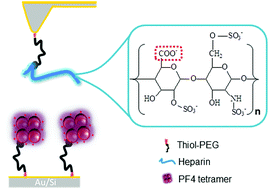Quantitative description of thermodynamic and kinetic properties of the platelet factor 4/heparin bonds†
Abstract
Heparin is the most important antithrombotic drug in hospitals. It binds to the endogenous tetrameric protein platelet factor 4 (PF4) forming PF4/heparin complexes which may cause a severe immune-mediated adverse drug reaction, so-called heparin-induced thrombocytopenia (HIT). Although new heparin drugs have been synthesized to reduce such a risk, detailed bond dynamics of the PF4/heparin complexes have not been clearly understood. In this study, single molecule force spectroscopy (SMFS) is utilized to characterize the interaction of PF4 with heparins of defined length (5-, 6-, 8-, 12-, and 16-mers). Analysis of the force–distance curves shows that PF4/heparin binding strength rises with increasing heparin length. In addition, two binding pathways in the PF4/short heparins (≤8-mers) and three binding pathways in the PF4/long heparins (≥8-mers) are identified. We provide a model for the PF4/heparin complexes in which short heparins bind to one PF4 tetramer, while long heparins bind to two PF4 tetramers. We propose that the interaction between long heparins and PF4s is not only due to charge differences as generally assumed, but also due to hydrophobic interaction between two PF4s which are brought close to each other by long heparin. This complicated interaction induces PF4/heparin complexes more stable than other ligand–receptor interactions. Our results also reveal that the boundary between antigenic and non-antigenic heparins is between 8- and 12-mers. These observations are particularly important to understand processes in which PF4–heparin interactions are involved and to develop new heparin-derived drugs.


 Please wait while we load your content...
Please wait while we load your content...